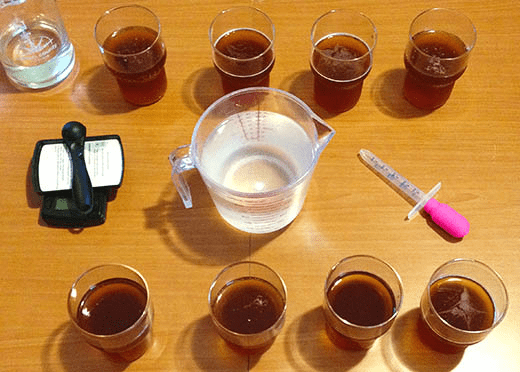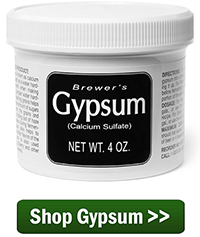 I recently dove head on into the world of water treatments for homebrewing. I’ve always made changes to my brewing water to control mash pH, but I decided it was time to look at water from a historical/regional perspective to see exactly how does gypsum affect beer flavor. Gypsum, also known as calcium sulfate, is a major component in many of the brewing water profiles used around the world. But, does adding gypsum to beer really make a difference in flavor?
I recently dove head on into the world of water treatments for homebrewing. I’ve always made changes to my brewing water to control mash pH, but I decided it was time to look at water from a historical/regional perspective to see exactly how does gypsum affect beer flavor. Gypsum, also known as calcium sulfate, is a major component in many of the brewing water profiles used around the world. But, does adding gypsum to beer really make a difference in flavor?
Let’s back up for a moment to review one of the ways water and its mineral content, or hardness, can impact your homebrew’s flavor. Different regions of the world have different mineral compositions in their brewing water supply. These differences can be significant. Just look at the levels (ppm) of these common minerals in Burton-on-Trent (UK) vs. Plzn:
|
Burton-on-Trent |
Plzen |
|
|
Calcium |
294 |
7 |
|
Carbonate |
200 |
15 |
|
Chloride |
36 |
5 |
|
Magnesium |
24 |
2 |
|
Sodium |
24 |
2 |
|
Sulfate |
800 |
5 |
In these two examples, it’s believed that the high sulfate water of Burton-on-Trent led to the development of bitters and pale ales, whereas the soft water of Plzen in Bohemia (now the Czech Republic) was suited to the creation of crisp, clean lagers. Homebrewers have the ability to mimic regional brewing water profiles by adding gypsum to beer along with others such as calcium carbonate.
Having just brewed and English Bitter, I was curious how a Burton brewing water profile might affect the flavors in the beer. After doing some research, I came across an experiment to help gauge the effects of a mineral salt on a beer. It goes like this:
- Prepare concentrated solutions using the mineral salt in question. For my test, I’m using gypsum. I started with filtered or distilled water and add measured amounts of the salt in one-gram increments into 500ml or 1L volumes of water.
- Measure out equal beer samples. Be sure to use a consistent volume and record it in your notes.
- Add 1 ml of each solution to the different samples. After doing the first round of taste tests, you might try adjusting the concentration of the solution.
- Take notes on how the flavor changes and find your ideal adjustment. Be sure to have some water and possibly some unsalted, relatively bland crackers or bread between each sample to cleanse your palate.
- Calculate how much salt would be needed for a full volume batch of beer.
So how did my experiment go? Did adding gypsum to beer affect its flavor?
Initially, the concentration of gypsum I was adding to the beer was too low to make any difference. I started with a 1 gram gypsum/500 mL water solution. Adding 1 mL of said solution to a 125 mL sample of beer only increased the effective concentration of by 1.6 ppm – an imperceptible change for my palate. As you can see, it would take a very concentrated amount of gypsum/water solution to simulate the Burton water profile. What I ended up doing was stirring about .5 gram of gypsum into a .5 L sample of beer to come close to the level of Burton water in the English bitter. Using this concentration of gypsum absolutely affected the beer’s flavor. The hops went from a background bitterness to a full floral sensation that covered the whole mouth. I will definitely use more gypsum in future pale ales.
 Using the method above you can begin to get a stronger understanding of how to adjust your brewing water. Just remember different salts affect beers in different ways, and different styles may lend themselves to different mineral concentrations. Experiment, test, record your results!
Using the method above you can begin to get a stronger understanding of how to adjust your brewing water. Just remember different salts affect beers in different ways, and different styles may lend themselves to different mineral concentrations. Experiment, test, record your results!
While the above experiment does give us some ideas as to how adding gypsum to beer affects its flavor, it does leaves some questions. In particular, how does mashing and boiling the hard, gypsum-infused water throughout the brewing process affect the perception of different flavors?
What is your take on the subject? Share in the comments below!
—–
David Ackley is a beer writer, brewer, and self-described “craft beer crusader.” He holds a General Certificate in Brewing from the Institute of Brewing and Distilling and is founder of the Local Beer Blog.

You added gypsum to beer that was already brewed. The true effect of gypsum in beer can only be realised it you actually brew beer with the water you’ve treated! The water will react differently with the grain during the mash stage. Since pH is affected by addition of gypsum, this in turn has a huge affect on the entire brewing process. So your test of adding gypsum after the beer is brewed is completely inconclusive.
To really test this, you would need to brew two batches of homebrew, identical in every way, except one using treated water and one using untreated water right from the beginning.
While Mike makes a great point about the mash addition of gypsum and mash pH, we should also consider the possibility of a boil addition of mineral salts. This would mimic the conditions of adding a mineral salt to a finished beer, though certainly microbial interactions with those salts might also play a role in shaping flavors during fermentation. My research indicates that gypsum added during the boil can indeed increase the perceived bitterness and overall flavor profile of the hops.
Testing these multiple conditions, i.e. boil addition of mineral salts v. mineral salts added to finished beer would be an interesting experiment.